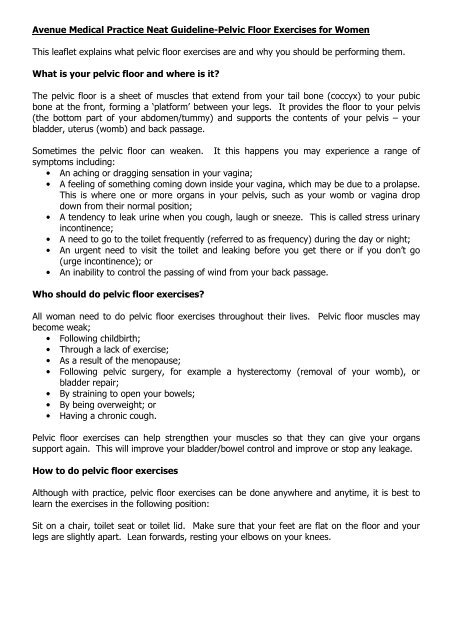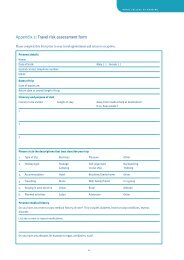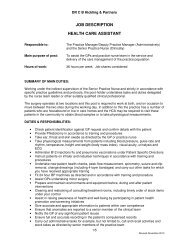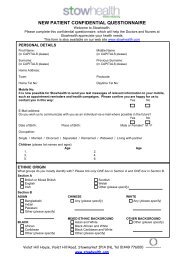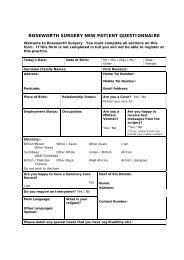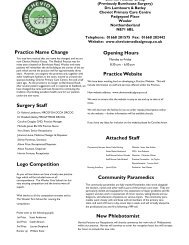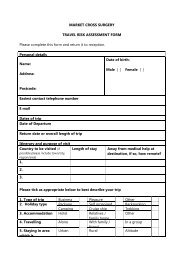Pelvic Floor Exercises for Women
Pelvic Floor Exercises for Women
Pelvic Floor Exercises for Women
Create successful ePaper yourself
Turn your PDF publications into a flip-book with our unique Google optimized e-Paper software.
Avenue Medical Practice Neat Guideline-<strong>Pelvic</strong> <strong>Floor</strong> <strong>Exercises</strong> <strong>for</strong> <strong>Women</strong>This leaflet explains what pelvic floor exercises are and why you should be per<strong>for</strong>ming them.What is your pelvic floor and where is it?The pelvic floor is a sheet of muscles that extend from your tail bone (coccyx) to your pubicbone at the front, <strong>for</strong>ming a ‘plat<strong>for</strong>m’ between your legs. It provides the floor to your pelvis(the bottom part of your abdomen/tummy) and supports the contents of your pelvis – yourbladder, uterus (womb) and back passage.Sometimes the pelvic floor can weaken. It this happens you may experience a range ofsymptoms including:• An aching or dragging sensation in your vagina;• A feeling of something coming down inside your vagina, which may be due to a prolapse.This is where one or more organs in your pelvis, such as your womb or vagina dropdown from their normal position;• A tendency to leak urine when you cough, laugh or sneeze. This is called stress urinaryincontinence;• A need to go to the toilet frequently (referred to as frequency) during the day or night;• An urgent need to visit the toilet and leaking be<strong>for</strong>e you get there or if you don’t go(urge incontinence); or• An inability to control the passing of wind from your back passage.Who should do pelvic floor exercises?All woman need to do pelvic floor exercises throughout their lives. <strong>Pelvic</strong> floor muscles maybecome weak;• Following childbirth;• Through a lack of exercise;• As a result of the menopause;• Following pelvic surgery, <strong>for</strong> example a hysterectomy (removal of your womb), orbladder repair;• By straining to open your bowels;• By being overweight; or• Having a chronic cough.<strong>Pelvic</strong> floor exercises can help strengthen your muscles so that they can give your organssupport again. This will improve your bladder/bowel control and improve or stop any leakage.How to do pelvic floor exercisesAlthough with practice, pelvic floor exercises can be done anywhere and anytime, it is best tolearn the exercises in the following position:Sit on a chair, toilet seat or toilet lid. Make sure that your feet are flat on the floor and yourlegs are slightly apart. Lean <strong>for</strong>wards, resting your elbows on your knees.
There are two types of exercises – slow twitch and fast twitch. It is important that you dothe slow twitch first and then the fast twitch each time you exercise your pelvic floor muscles.To per<strong>for</strong>m the slow twitch exercises:1. Close and draw up the muscles around back passage, as if you are trying to stop passingwind. Make sure that you do not contract your buttock muscles while you do this.2. Now close and draw up the muscles around your vagina and urethra, as though you aretrying to stop the flow of urine.3. Hold <strong>for</strong> a count of five. Try not to hold your breath, breathe normally.4. Then slowly relax and let go.5. Repeat five times in totalTo per<strong>for</strong>m the fast twitch exercises:1. Pull up the pelvic floor muscles as be<strong>for</strong>e.2. Hold <strong>for</strong> one second and then relax.3. Repeat 5-10 times or until your muscles feel tired.The pelvic floor muscles tire easily and you may notice that it takes a lot of concentration tobegin with to do these exercises correctly.If you find that the muscles ‘let go’ too quickly and that you cannot hold <strong>for</strong> a count of five, justhold them <strong>for</strong> as long as you can. Use this as your baseline. For example, if you can only holdthe contraction <strong>for</strong> a count of three, then every time you do your exercises, contract themuscles <strong>for</strong> a count of three. Gradually try to work up to four, then five.It is important to try not to:• Squeeze your buttocks together;• Bring your knees together;• Hold your breath; or• Lift your shoulders/eyebrows or toes upwards.If you do any of these, you are not contracting (tightening) your muscles correctly.How often should I do my exercises?Practice five pelvic floor contractions (as explained previously) five times a day. Make sure thatit is a good contraction every time.You can feel your pelvic floor contracting by putting one or two fingers into your vagina whilsthaving a bath or shower. Tighten your pelvic floor so that the muscles squeeze your fingerhard.Every two weeks, test the strength of your pelvic floor by stopping the flow of urine midstream.This will feel similar to the exercises above and uses the same muscles. You may notbe able to completely stop the flow of urine to begin with, but you may notice that you are ableto slow the flow down. Gradually over the weeks you should notice an improvement. It isimportant that you do not do this test more than once a <strong>for</strong>tnight as it may cause problemswith your bladder. This is just a test to see how you are progressing.Do not expect instant results!It will take several weeks of regular exercise to regain the strength in your pelvic floor muscles.You need to do these exercises <strong>for</strong> the rest of your life. If you stop exercising, your problemswill return.


